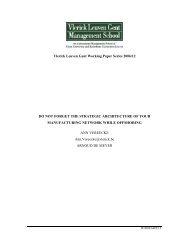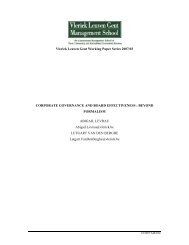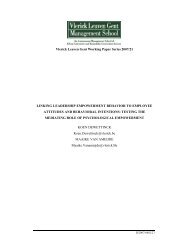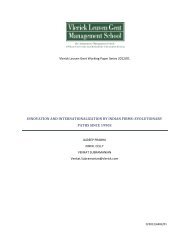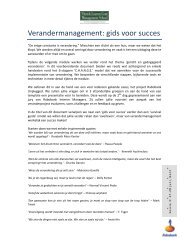an experimental investigation of the interactions ... - Vlerick Public
an experimental investigation of the interactions ... - Vlerick Public
an experimental investigation of the interactions ... - Vlerick Public
Create successful ePaper yourself
Turn your PDF publications into a flip-book with our unique Google optimized e-Paper software.
supplier <strong>of</strong> wood, which is <strong>the</strong> most import<strong>an</strong>t component <strong>of</strong> parquet floors <strong>an</strong>d <strong>an</strong> import<strong>an</strong>tdetermin<strong>an</strong>t <strong>of</strong> customer satisfaction, has stopped <strong>the</strong> production <strong>of</strong> wood for parquet floors. Inorder to make <strong>the</strong> <strong>experimental</strong> task not overly complex, it was told to <strong>the</strong> particip<strong>an</strong>ts that <strong>the</strong>overall perform<strong>an</strong>ce <strong>of</strong> a supplier is based on two metrics: <strong>the</strong> total costs <strong>of</strong> a supplier <strong>an</strong>d <strong>the</strong>revenue-generating possibilities <strong>of</strong> a supplier. The total costs <strong>of</strong> a supplier refer to all <strong>the</strong> costs that asupplier causes within <strong>the</strong> firm such as purchasing cost, costs <strong>of</strong> waste, storage costs <strong>an</strong>dadministrative costs. 4 The revenue-generating possibilities <strong>of</strong> a supplier refer to <strong>the</strong> influence asupplier has on customer satisfaction <strong>an</strong>d thus on <strong>the</strong> revenues <strong>of</strong> <strong>the</strong> firm to which <strong>the</strong> supplierdelivers his goods <strong>an</strong>d services. Although suppliers were traditionally evaluated on <strong>the</strong> total coststhat <strong>the</strong>y cause in <strong>the</strong> buying firm, comp<strong>an</strong>ies are increasingly aware <strong>of</strong> <strong>the</strong> fact that suppliers alsoc<strong>an</strong> generate revenues if <strong>the</strong> characteristics <strong>of</strong> <strong>the</strong> goods <strong>an</strong>d services <strong>the</strong>y deliver match withcustomer preferences (Pl<strong>an</strong>k <strong>an</strong>d Ferrin 2002). Consequently, in order to select a supplier thatoptimizes firm perform<strong>an</strong>ce, purchasing m<strong>an</strong>agers have to make a trade-<strong>of</strong>f between <strong>the</strong> total coststhat a supplier causes <strong>an</strong>d <strong>the</strong> revenues that he generates (Wouters et al. 2005). To focus subjects’attention on <strong>the</strong> trade-<strong>of</strong>f between <strong>the</strong> total costs <strong>an</strong>d <strong>the</strong> revenue-generating possibilities, <strong>the</strong> intrafirmcooperation is limited to cooperation between <strong>the</strong> purchasing department, which <strong>of</strong>tencalculates <strong>the</strong> total costs <strong>of</strong> a supplier, <strong>an</strong>d <strong>the</strong> marketing department, which has a good idea aboutcustomer preferences <strong>an</strong>d <strong>the</strong> impact <strong>of</strong> a new supplier on <strong>the</strong> firm’s revenues (Ivens et al. 2009). Itis import<strong>an</strong>t to mention that subjects in all <strong>the</strong> conditions receive <strong>the</strong> same information about <strong>the</strong>total costs. Specifically, for each supplier, <strong>the</strong>y all receive one number that reflects <strong>the</strong> total costs <strong>of</strong>that particular supplier. Our m<strong>an</strong>ipulation <strong>of</strong> <strong>the</strong> information system varies <strong>the</strong> way in which <strong>the</strong>revenue-generating possibilities <strong>of</strong> a supplier are represented. This will be explained in Section 3.3 <strong>of</strong>this study.After reading <strong>the</strong> scenario, subjects had to make six supplier selections. Each supplierselection was presented on one screen. Subjects could take as much time as <strong>the</strong>y w<strong>an</strong>t to make adecision but once a final decision was made, <strong>the</strong>y could not ch<strong>an</strong>ge <strong>the</strong>ir decision <strong>an</strong>ymore. To avoidorder effects, <strong>the</strong> sequence <strong>of</strong> <strong>the</strong> six supplier selections was r<strong>an</strong>domized. Subjects receivedinformation about <strong>the</strong> total costs <strong>an</strong>d <strong>the</strong> revenue-generating possibilities for each <strong>of</strong> <strong>the</strong> two newsuppliers as well as for <strong>the</strong> current supplier. To avoid that <strong>the</strong> results are driven by <strong>the</strong> movement <strong>of</strong><strong>the</strong> total costs towards <strong>the</strong> current supplier, we differed <strong>the</strong> six supplier selections with respect to<strong>the</strong> movement <strong>of</strong> <strong>the</strong> total costs towards <strong>the</strong> current supplier. 54 The total costs <strong>of</strong> a supplier are similar to <strong>the</strong> Total Cost <strong>of</strong> Ownership <strong>of</strong> a supplier (Degraeve <strong>an</strong>d Roodho<strong>of</strong>t 2001).However, to avoid <strong>an</strong>y connotations with this technique, we do not label <strong>the</strong> total costs <strong>of</strong> a supplier as <strong>the</strong> ‘Total Cost <strong>of</strong>Ownership’.5 In two supplier selections, <strong>the</strong> total costs <strong>of</strong> both suppliers was higher compared to <strong>the</strong> total costs <strong>of</strong> <strong>the</strong> current supplier,in two supplier selections <strong>the</strong> total costs <strong>of</strong> both suppliers was lower compared to <strong>the</strong> total costs <strong>of</strong> <strong>the</strong> current supplier,13



